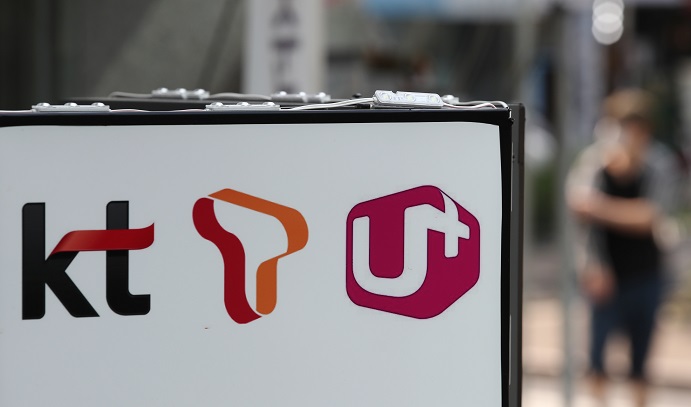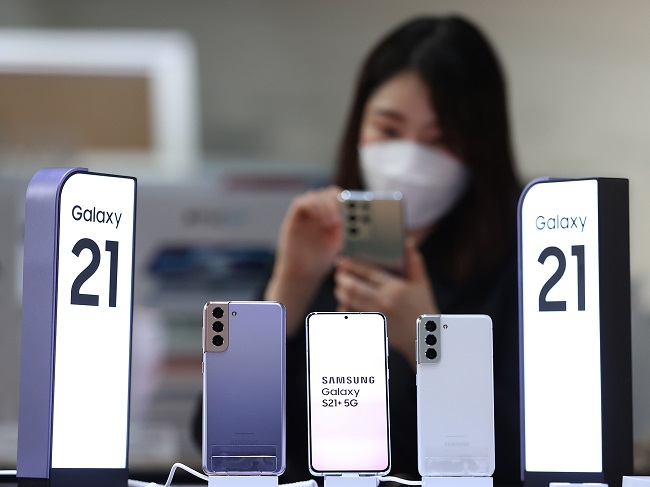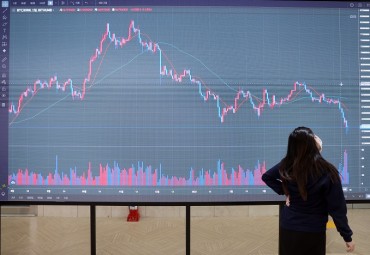
The logos of South Korea’s major telecom operators — KT Corp., SK Telecom Co. and LG Uplus Corp. — are shown in this file photo taken July 8, 2020. (Yonhap)
SEOUL, April 11 (Korea Bizwire) — South Korean wireless carriers are estimated to have logged robust earnings in the first quarter on the back of sharp growth in 5G users and their non-telecom businesses, a poll showed Sunday.
The combined operating profits of the country’s three major mobile carriers — SK Telecom Co., KT Corp. and LG Uplus Corp. — are expected to have reached 966.5 billion won (US$863.3 million) in the January-March period, up 6.8 percent from the previous year, according to the poll on six local brokerage houses by Yonhap Infomax, the financial arm of Yonhap News Agency.
SK Telecom, the biggest of the three in terms of mobile users, is estimated to have posted an operating profit of 339.5 billion won for the first quarter, up 12.42 percent on-year, while its revenue probably rose 6.57 percent on-year to 4.74 trillion won.
Telecom giant KT is expected to have logged 386.3 billion won in operating profit, up 0.84 percent on-year, while the operating profit of LG Uplus is estimated to have risen 9.51 percent to 240.7 billion won.
Analysts said their strong bottom lines come as mobile subscribers to 5G networks sharply rose this year.
“As 5G penetration increases, service sales growth is in full swing, while marketing costs are expected to decline,” Hana Financial Investment analyst Kim Hong-sik said.
South Korea added around 1.8 million 5G users in the first two months of this year, reaching a total of 13.66 million, which accounts for 19 percent of all mobile service subscriptions, according to data from the Ministry of Science and ICT.
SK Telecom had 6.35 million 5G users in February, followed by KT at 4.16 million and LG Uplus at 3.15 million.
Wireless data traffic from 5G smartphones that month accounted for 47 percent of the total.
“With the release of affordable 5G data plans as well as budget 5G phones, net growth in 5G users is expected to increase,” Kim added.

This file photo, taken Jan. 15, 2021, at a store in central Seoul, shows Samsung Electronics Co.’s new Galaxy S21 series phones that support 5G. (Yonhap)
Mobile carriers released more price-competitive 5G data plans earlier this year through online stores.
The companies said they were able to cut costs as those plans solely use online retail channels, which require fewer expenses compared with traditional brick-and-mortar stores.
Analysts are also upbeat about growth in SK Telecom’s non-telecom businesses, which ranges from e-commerce operator 11Street Co. to the country’s second-largest taxi-hailing app operator T Map Mobility Co.
“Aside from telecommunications, SK Telecom will likely have improved earnings as it prepares to make its subsidiaries public,” SK Securities analyst Choi Kwan-sun said.
“It is also expected to acquire growth momentum over the long run through global partnerships, such as with Uber in the mobility sector and Amazon in the e-commerce sector.”
SK Telecom has said its app market subsidiary ONE Store will go public sometime this year.
T Map Mobility has launched taxi-hailing joint venture UT with U.S. ride-hailing firm Uber Technologies Inc.
KT has also boosted its focus on the non-telecom sector, setting up new media subsidiary KT Studio Genie earlier this year.
(Yonhap)






